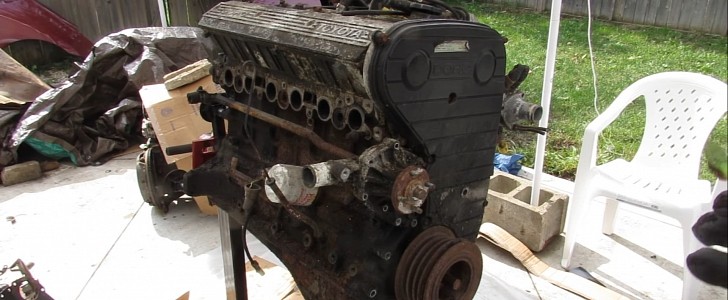The JZ is arguably the most famous Toyota engine in the car-loving community. Launched in 1990 and discontinued in 2007, the JZ was preceded by the long-running M series that rolled out back in 1965.
Originally designed with a chain-driven single camshaft, the M family gained a belt-drive DOHC valvetrain in the 1980s. The 5M-GE featured in the following video came from a 1986 Toyota Supra, and obviously enough, its condition is pretty fair even though it needs some tender loving care.
YouTube mechanic speedkar99 begins the teardown process by highlighting the most common issue of the 2.8-liter engine, namely blown head gaskets. Some 5M-GE mills fail because the head bolt torque is too low from the factory, which goes to show that not even the most reliable automaker out there is 100% on top of its game on every single occasion.
The cast-iron block is complemented by aluminum for the head and stamped steel for the oil pan, a pretty classic trio for a powerplant from the 1980s. The mechanical throttle body is dirty as you would expect a 35-year-old throttle body to be. As for the intake ports, they’re clean as they can be thanks to electronic fuel injection rather than direct fuel injection. GDI has this nasty habit of carbon buildup on the intake valves whereas EFI prevents carbon buildup with the inherent cleaning properties of unleaded gasoline.
According to the man with the toothbrush, “the M series of engines are a good example of what Toyota can do in order to build a very reliable and strong engine that can definitely take a lot more power. It’s too bad they don’t really build anything like this anymore,” concluded the mechanic.
On that note, only two M-series engines were offered with forced induction. First came the M-TEU in 1980 with 145 horsepower on tap. Then came the 7M-GTE used by the Supra, Soarer, Chaser, Crown, and the Cressida.
YouTube mechanic speedkar99 begins the teardown process by highlighting the most common issue of the 2.8-liter engine, namely blown head gaskets. Some 5M-GE mills fail because the head bolt torque is too low from the factory, which goes to show that not even the most reliable automaker out there is 100% on top of its game on every single occasion.
The cast-iron block is complemented by aluminum for the head and stamped steel for the oil pan, a pretty classic trio for a powerplant from the 1980s. The mechanical throttle body is dirty as you would expect a 35-year-old throttle body to be. As for the intake ports, they’re clean as they can be thanks to electronic fuel injection rather than direct fuel injection. GDI has this nasty habit of carbon buildup on the intake valves whereas EFI prevents carbon buildup with the inherent cleaning properties of unleaded gasoline.
According to the man with the toothbrush, “the M series of engines are a good example of what Toyota can do in order to build a very reliable and strong engine that can definitely take a lot more power. It’s too bad they don’t really build anything like this anymore,” concluded the mechanic.
On that note, only two M-series engines were offered with forced induction. First came the M-TEU in 1980 with 145 horsepower on tap. Then came the 7M-GTE used by the Supra, Soarer, Chaser, Crown, and the Cressida.



















